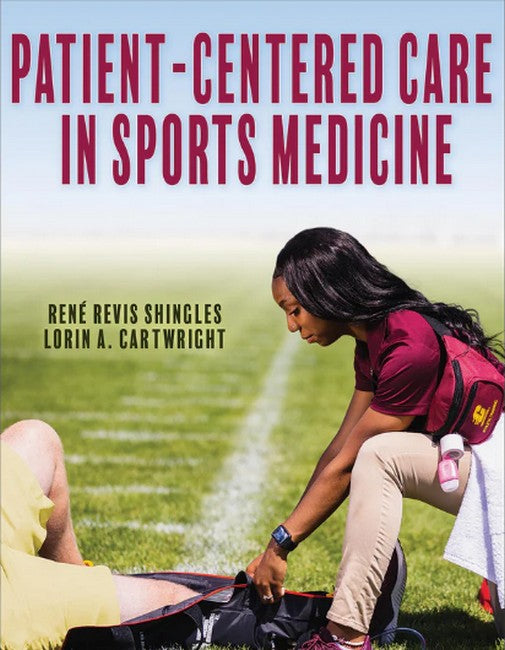Rene Revis Shingles, PhD, ATC, is an award-winning educator, author, and servant leader. She is a professor emeritus in the athletic training program at Central Michigan University and previously served as the program director, internship coordinator, and representative chair of the School of Rehabilitation and Medical Sciences. Shingles currently serves as president of the Board of Certification (BOC) board of directors and is the first African American to hold the position. She previously served as vice president for the BOC board of directors. She has written numerous research articles and is the coauthor, with Lorin Cartwright, of Cultural Competence in Sports Medicine.
Shingles holds a bachelors degree in education from the University of North Carolina at Chapel Hill, a masters degree in athletic training from Illinois State University, and a doctorate in kinesiology from Michigan State University. She has provided athletic training services for high school, collegiate, recreational, special Olympics, and elite-level athletes, including as a member of the 1996 U.S. Olympic team medical staff. She has received many national, regional, state, and local awards for outstanding teaching, leadership, professional service, and community service. In 2018, she became the first African American woman inducted into the hall of fame of the National Athletic Trainers Association (NATA). She served on the NATAs inaugural Ethnic Diversity Advisory Committee as well as the LGBTQ+ Advisory Committee. In addition to her full professional life, she loves making time to mentor students.
Lorin A. Cartwright, MS, ATC, is retired from her roles as head athletic trainer, assistant principal, and athletic director at Pioneer High School in Ann Arbor, Michigan, where she served for more than 32 years. She was an adjunct professor in athletic training at the University of Michigan for three years and also taught at Eastern Michigan University and Concordia University. Cartwright was the first woman to graduate from Grand Valley State University with a degree in athletic training, and she later became the first woman and the first high school athletic trainer to become president of the Great Lakes Athletic Trainers Association. She has been appointed by the governor of Michigan to the Michigan Board of Athletic Trainers and the Michigan Task Force on Women in Sports.
Cartwright has been an active member of the LGBTQ+ Advisory Committee of the National Athletic Trainers Association (NATA). She was the cochair of the Diversity Equity and Inclusion Committee of the Michigan Athletic Trainers Society. In 2022 she was honored with NATAs Gail Weldon Award of Excellence. In 2010, she was awarded the Outstanding Educator Award by the Great Lakes Athletic Trainers Association. She has been inducted into the halls of fame of Pioneer High School, the Michigan Athletic Trainers Society, the Great Lakes Athletic Trainers Association, and the National Athletic Trainers Association.
She has been involved in presentations on ally training, implicit bias, cultural competence in health care, and Title IX. Her articles include "Employment Discrimination in Athletic Training: A Case Study," "Integrating Safe Space Ally Training Into the AT Curriculum," "Minority Stress and Its Impact on Mental Health in LGBTQ+ Patients and Athletic Trainers and Patients Who Identify as LGBTQ+," "Stressors of Sexual Minority Identity and How It Affects Mental Health," and "Considerations in Addressing Bias to Ensure Inclusion and Healthcare." She has authored or coauthored eight books about the athletic training profession and two ebooks on athletic training certification.
Request Academic Copy
Please copy the ISBN for submitting review copy form
Description
Contents: Part I. Exploring Patient-Centered Care
Chapter 1. Defining Patient-Centered Care
What Is Patient-Centered Care?
Frameworks of Patient-Centered Care
Why Is Patient-Centered Care Important?
Terminology and Language
Summary
Chapter 2. Demographics, Social Determinants of Health, and Health Disparities
What Are Health Disparities?
Changing Demographics
Social Determinants of Health
Relationship Between Demographics, Social Determinants of Health, and Health Disparities
Reducing Health Disparities
A Social Justice Lens: Advocating for Patients
Summary
Part II. Patient-Centered Awareness
Chapter 3. Understanding Difference
Unpacking the Luggage
Repacking the Luggage
Summary
Chapter 4. Understanding Oneself
Cultural Awareness and Self-Assessment
Everyone Has Culture
Generalizations, Stereotypes, Prejudices, and Implicit Bias
Microagressions : Microassaults, Microinsults, Microinvalidations, and Environmental Microaggressions
Advantages, Disadvantages, and Privileges
Summary
Part III. Patient-Centered Communication
Chapter 5. Eliciting Information
The Explanatory Models Approach, Outline for Cultural Formulation, and Cultural Formulation Interview
Other Models for Eliciting Information
Eliciting Information Through Use of an Interpreter
Patient Forms and Data Gathering
Summary
Chapter 6. Patient-Centered and Culturally Based Physical Assessment
Taking an Oral History
Inspecting and Observing Physical Signs
Palpating
Summary
Chapter 7. Patient and Family Engagement
Framework for Patient and Family Engagement
Factors That Influence Patient and Family Engagement
Strategies for Addressing Barriers to Engagement
Summary
Chapter 8. Introducing Patient-Centered Care in the Athletic Training Facility
Implementing Patient-Centered Care
Implementation Considerations
Summary
Part IV. Patient-Centered Knowledge
Chapter 9. Native Americans
American Indians
Native Alaskans
Summary
Chapter 10. Asian Americans and Pacific Islander Americans
Chinese Americans
Indian Americans
Filipino Americans
Summary
Chapter 11. Black Americans
African Americans
Nigerian Americans
Jamaican Americans
Summary
Chapter 12. Latino and Hispanic Americans
Mexican Americans
Puerto Ricans
Cuban Americans
Summary
Chapter 13. White Euro-Americans
German Americans
Irish Americans
English Americans
Summary
Chapter 14. Middle Eastern North African Americans
Iraqi Americans
Egyptian Americans
Lebanese Americans
Summary
Chapter 15. Lesbian, Gay, Bisexual, Transgender Americans
Overview and Framework
Historical Perspectives
Demographic Characteristics
Cultural and Psychosocial Challenges
Coming Out or Inviting In
Lesbian
Gay
Bisexual
Transgender
Summary
Chapter 16. Americans With Disabilities
Limb Deficiencies
Deaf or Hard of Hearing
Blindness or Limited Vision
Summary
Appendix A. Satisfaction Survey
Appendix B. Patient-Centered Athletic Training Facility Guidelines and Checklist
Appendix C. Sample Policies and Procedures
Appendix D. Religious and Spiritual Orientations

